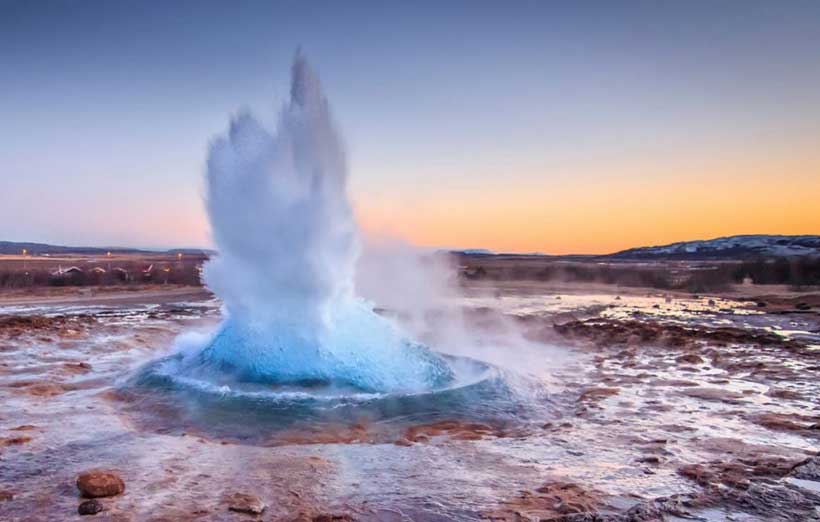Geothermal energy is used to combat climate change
As an alternative to oil, Iceland uses the Blue Lagoon, a hot spring located in the southwest corner of the country and just one example of a geothermal energy source (4). Geothermal energy is a process by which heat from the earth is harnessed and used for heating and electricity (5). Geothermal energy sources, like that of the Blue Lagoon, supply up to 20% of Iceland’s electricity, while geothermal water is utilized to heat 90% of Iceland’s homes (1). As seen in Ireland and other countries adapting to geothermal energy, this alternative source of electricity has the potential to ameliorate global warming impacts.
It is estimated that by 2050, global temperatures will have risen by at least 2.5 degrees Celsius (7). This severe increase in temperature is due to global warming, a phenomenon where global temperatures rise due to greenhouse gas emissions such as carbon dioxide production (CO2) (6). Therefore, by mitigating the amount of CO2 that is released into the atmosphere, Iceland has made significant strides towards protecting the planet from this severe climate crisis.
However, Iceland’s intentions with geothermal energy extend far beyond its environmental impacts. Iceland uses geothermal energy to support both our global climate and their economy; it is estimated that Iceland has saved $8.2 billion over the last 30 years by using geothermal energy as opposed to oil (1). There are 600 hot springs in Iceland which provide plenty of opportunities for geothermal energy use (1). In fact, scientists predict that Iceland has not yet reached the full potential of its geothermal energy sources, and that only 20% of all accessible geothermal energy in Iceland has been harnessed.

Due to its geographical location, Iceland is naturally fit to be a leader in geothermal energy production. However, in terms of the total amount of electricity produced through geothermal sources, the United States (U.S.) is a global superpower (8). There are geothermal power plants in seven states, primarily in the West, which produce around 16 billion kilowatt hours of electricity (8). Despite that seemingly large number, that is only 0.4% of total U.S. utility-scale electricity generation (8) which is still dominated by fossil fuels. Burning oil and other fossil fuels prompts the release of CO2 into the atmosphere and worsens the climate crisis. Thus, the U.S will have to start relying more heavily on alternate “green” energies such as geothermal power.
In Iceland, their alternative to fossil fuels comes in the form of hydropower and geothermal sources. As of 2015, renewable energy provided 100% of Iceland’s electricity; 73% of that energy came from hydropower, and 27% from geothermal sources (2). By utilizing natural resources such as their hot springs, Iceland has been able to create a sustainable and profitable way of obtaining energy.

Iceland provides an exemplary model for countries like the United States, who rely heavily on fossil fuels. In order to guard against this climate crisis, countries will have to start being more environmentally conscious, and model their energy plans off of countries like Iceland and their impressive geothermal energy efforts.
Citations
- Aldred, J. (2008, April 22). Iceland’s energy answer comes naturally. The Guardian; The Guardian. https://www.theguardian.com/environment/2008/apr/22/renewableenergy.alternativeenerg
- Energy. (2016). Government.is. https://www.government.is/topics/business-and-industry/energy/#:~:text=Renewable%20energy%20provided%20almost%20100,supplier%20of%20electricity%20in%20Iceland
- Frequently Asked Questions (FAQs) – U.S. Energy Information Administration (EIA). (2018). Eia.gov. https://www.eia.gov/tools/faqs/faq.php?id=427&t=3
- Geothermal. (2014). National Energy Authority of Iceland. https://nea.is/geothermal/#:~:text=Direct%20Use%20of%20Geothermal%20Resources,used%20directly%20in%20many%20ways
- Geothermal energy | Description, Uses, History, & Pros and Cons | Britannica. (2022). In Encyclopædia Britannica. https://www.britannica.com/science/geothermal-energy
- Nunez, C. (2019, May 13). Carbon dioxide levels are at a record high. Here’s what you need to know. Environment; National Geographic. https://www.nationalgeographic.com/environment/article/greenhouse-gases
- Rebecca Lindsey, Luann Dahlman (2021, March 15). Climate Change: Global Temperature. NOAA. https://www.climate.gov/news-features/understanding-climate/climate-change-global-temperature#:~:text=According%20to%20NOAA’s%202020%20Annual,more%20than%20twice%20that%20rate.
- Use of geothermal energy – U.S. Energy Information Administration (EIA). (2018). Eia.gov. https://www.eia.gov/energyexplained/geothermal/use-of-geothermal-energy.php#:~:text=The%20United%20States%20leads%20the,U.S.%20utility%2Dscale%20electricity%20generation
Images:
- https://taraenergy.com/blog/geothermal-energy-learning/
- https://moderndiplomacy.eu/2020/06/25/iceland-a-world-leader-in-clean-energy-supports-africas-push-for-geothermal-power/
